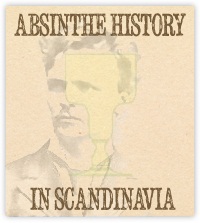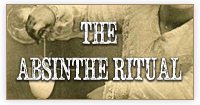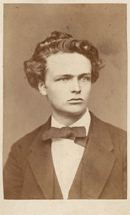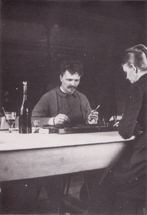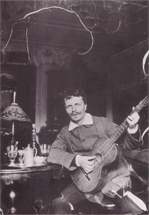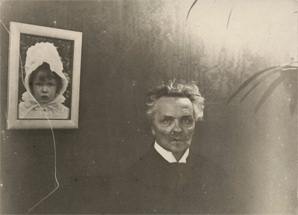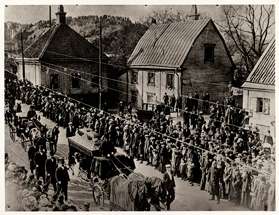Absinthe.se
The premier independent absinthe resource since 2003
Musset didn't write the way he did because he drank absinthe, instead he drank for the same reason for which he wrote just like that: namely out of despair.
Tjänstekvinnans Son
(The Son of a Servant)
August Strindberg, 1849-1912
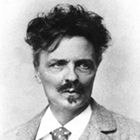
Swedish playwright, novelist, and short-story writer, who combined psychology and Naturalism in a new kind of European drama that evolved into Expressionist drama. His play Miss Julie (1888) remains today the most concentrated example of the first step in the development of Modern drama because it shattered old illusions about the meaning and worth of human existence and 19th century assumptions about the way existence could be presented in theater.
During his years in Paris in the 1880's he came across absinthe, just as every other person in France around that time. A drink he came to both love and hate and mention in several of his works.
During his years in Berlin he was part of a group of artists and writers often seen at the Zum Schwarzen Ferkel, a local tavern. The group was mainly nordic artists such as himself and Edvard Munch but also included Polish writer and journalist Stanislaw Przybyszewski and not to forget - the woman they all wanted, Dagny Juel.
August Strindberg and absinthe
This is by no means supposed to be a deep dive into Strindberg's many works or an analysis of his life and mental health. There are several other works on that by people with far more expertise on the subject than me. I am not even going to mention some of his most famous pieces. This is simply a look into what part absinthe played in both his works and the life of August Strindberg. It is also likely to be a work in constant progress as I find more along the way to complete the picture.
The early years
August Strindberg was born on 22 January 1849 in Stockholm, Sweden, son of Carl Oscar Strindberg and Eleonora Ulrika Norling. His childhood was anything but smooth and Strindberg himself describes it as strongly affected by emotional insecurity, poverty, religious fanaticism and neglect. Clearly something that would influence Strindberg in all of his life. In his autobiographical novel Tjänstekvinnans son (Son of a Servant) Strindberg deals with this part of his life.
In 1867 Strindberg passed his graduation exam and enrolled at the Uppsala University. The next few years he would be in Uppsala studying. He studied chemistry as preparation for medical school but didn't pass the exam. In 1870 he returned after a brief break in his studies, to instead focus on aesthetics and modern languages.
Early works and first true love
During the beginning of the 1870's Strindberg worked on a number of plays and also as a journalist and critic for Swedish newspapers in Stockholm. In the summer of 1875 Strindberg first met Siri von Essen, an aspiring actress at the time married to Baron Carl Gustaf Wrangel. He immediately fell head over heels in love with her and in early 1875 Strindberg cancels a trip to Paris and stays in Dalarö after having a nervous breakdown - possibly caused by his love for Siri von Essen. In a letter to Siri, written while he is in the hospital Strindberg writes;
"The Fool - the other - has brought in a bottle of absinthe and wants to tempt me - it glows of spring green - but I feel there is someone telling me I cannot - I would consider it a crime or more - No, I do not want to! The pharmacist has promised us haschisch - but I do not want to."
The Fool, is someone Strindberg met in the hospital, someone who was also there to "mend his head".
The above letter is also included in the book Han och Hon (He and She) which is a compilation of the letters between August and Siri in book form. In it you can read the rest of the letter saying;
"Now the absinthe is starting to work on the fool! He's not used to it. - Ah, how it smells - but the temptation is over for me."
Eventually she fell for him as well and in 1876 after Siri had divorced Wrangel, August and Siri got married. Even this early in Strindberg's career he had formed a liking for absinthe and felt the need to stay away from it. Interesting since most "intellectuals" and also most ordinary people rather drank Punsch at that time in Sweden.
In November 1879 one of Strindberg's most famous works was published - Röda Rummet (The Red Room), a satire of Stockholm society. Much of the book takes place in a salon called The Red Room in the restaurant "Berns Salonger". At Berns everyone was welcome. Separated maybe, but welcome. The Red Room was where the "intellectuals" gathered. The Red Room includes plenty of references to absinthe and the most noticeable one is probably the fact that chapter 14 is titled Absinthe.
In the chapter absinthe plays a great part in a conversation between two characters in the story and Falander (the main character) asks a young waiter;
"Why don't you take some absinthe? Are you afraid of it? Look at the bottle! It's marked with the Geneva cross! It heals those who have been wounded on the battlefield, friends and foes alike; it dulls all pain, blunts the keen edge of thought, blots out memories, stifles all the nobler emotions which beguile humanity into folly, and finally extinguishes the light of reason."
Between 1880 and 1881 a collection of all Strindberg's previous short stories, I vårbrytningen (Spring Harvest), is published divided into seven booklets. Immediately after the seventh booklet is published the collection is also published as a book in its entirety.
In the first story Från Havet (From the Ocean) - chapter one, a short poem is included;
"I'm lying on the boatswain's locker
smoking "Fem Blå Bröder"
thinking of nothing
The sea is green
dark absinthe green
it is bitter like magnesium chloride
and saltier than sodium chloride
it is chaste like potassium iodide
and oblivion, oblivion
from major sins and great sorrows
you find only in the ocean,
and absinthe!
O green absinthe sea,
o calm absinthe oblivion,
numb my senses
and let me fall asleep in peace,
as I fell asleep before
over an article in
Revues des deux Mondes!
Sweden lies like smoke
like the smoke from a Maduro Havanna
and the sun is sitting above
like an almost extinguished cigar,
but around the horizon
the quarries stand red
like Bengal-fires
shedding light on the misery."
Further on in the second story Här och Där (Here and There) Strindberg writes about the break of spring at Djurgården. He describes the calm, enjoyable and predictable life he leads during the winter, drinking toddy in his favorite café and how much he likes it. Then, suddenly, come February...
"I couldn't switch my lamp on at 5 o'clock any longer for the sun didn't want to set. At the 7th I was attacked by three anemic children, who wanted to sell Hepaticas - I have always hated Hepaticas. This was then repeated every day. At the 9th I was awakened at 7.30 by a Chaffinch, though I didn't want to wake up until 8.30. This was soon followed by more, who every morning repeated this disturbing fracas. At the beginning of March things became more questionable. I entered my café - in the salon was six sofas, five were empty, the sixth - my sofa - was taken. I sat down in the fifth and ordered a cognac - why should I drink toddy?
I had long suspected this. The air became warm with the sun.
My overcoat became green on the shoulders and white in the buttonholes. Half year old stains emerged from the mossy graves of the wool; my hat was soaked by the rains, beneficial to the soil, and lay in deep folds across my forehead.
One evening - I want to try and forget it - I came to my regular evening locality. No one greeted me, no seats were available - I had to sit in the hall by the coachmen's table and drink absinthe - why should I drink cognac?
It was bitter. The next morning would however complete my misery. The raft was cancelled! He who has lived at Djurgården, knows what these words mean. I tried the steam boat, but he always sailed off when I came."
Taken out of context it would be easy to assume that it was the absinthe which was bitter, but it's clear that it was the whole situation he's referring to.
It is clear in these short stories that his time abroad, in Paris among other places, has influenced him greatly and in another part of the book, Från Fjärdingen till Svartbäcken (From Fjärdingen to Svartbäcken) (first published as a separate story in 1877) he writes a story named Skalden och Poeten (The Bard and the Poet). This is a story of two students who approach the art of poetry and the life of a student in completely different ways. The frowned upon and laughed at serious poet drenches his misery and sorrow in absinthe, whilst the loved and cherished one drinks toddy and punsch. Strindberg had no idea what was coming to him...
In 1883 one of the very few books Strindberg wrote entirely comprised of prose and poems, was published. It was titled Dikter på vers och prosa (Poems in Verse and Prose) and included this beautiful poem originally titled Indiansommar (Indian Summer). In all its beauty it is still harsh and bitter with the typical Strindberg sincerity and darkness.
From the sickroom's chloral smelling pillows,
darkened by suffocated sighs
and hitherto unheard blasphemes;
from the bedside table,
encumbered with medicinal bottles,
prayer books and Heine,
I stumbled out on the balcony
to look at the sea.
Shrouded in my flowered blanket
I let the October sun shine
on my yellow cheeks
and onto a bottle of absinthe,
green as the sea,
green as the spruce twigs
on a snowy street
where a funeral cortège had gone ahead.
The sea was dead calm
and the wind slept --
as if nothing had passed!
Then came a butterfly,
a brown awful butterfly,
which once was a caterpillar
but now crawled its way up
out of a newly set heap of leaves,
fooled by the sunshine
oh dear!
Trembling from cold
or unaccustomedness
he sat down
on my flowered blanket.
And he chose among the roses
and the anilin lilacs
the smallest and the ugliest one --
how can one be so stupid!
When the hour had passed
and I got up
to go and get inside,
he still sat there,
the stupid butterfly.
He had fulfilled his destiny
and was dead,
the stupid bastard!
Blasphemous rumors
In the beginning of the 1880's Strindberg also wrote several pieces that more or less attacked every aspect and part of society and social institutions. One of these was Likt och olikt (Like and Unlike), published in 1884. For this he was heavily criticized and eventually he felt the need to leave to let things calm down. He moved with his family to live at the Scandinavian artist colony in Grez, south of Paris, where famous persons such as Carl Larsson, Bruno Liljefors and many more also stayed. It would only be a few weeks until they left for Paris and then after a short while move to Ouchy, south of Lausanne by Lac Genève.
Whilst abroad Strindberg continues his writing with several autobiographical works and in 1884 August Strindberg starts writing what would become a milestone in his life - Giftas (Getting Married). In only six weeks he completed the book. Three months later, at September 27, Giftas hit the shelves in the bookstores. Only a week later the book is sequestrated and at October 7 it is charged with allegations of blasphemy. At November 17 the trial is finished and August Strindberg is freed from all charges and he is saluted by a crowd at Riddarhustorget. The next day, he returns with his family to Genève.
After the process of Giftas, Strindberg wrote the autobiographical novel Tjänstekvinnans son (Son of a Servant) which dealt with his childhood. In it he described the situation he grew up under and how it had formed him through life. Partially this was written as a form of explanation to why he had written Giftas. He somehow hoped this would help people understand where he came from. In this book Strindberg writes (my translation);
"Musset didn't write the way he did because he drank absinthe, instead he drank for the same reason for which he wrote just like that: namely out of despair."
Even Strindberg didn't attribute absinthe any creative virtues.
Among French Farmers
In 1884 an idea formed in Strindberg's mind. He wanted to travel the countries of Europe and document the country life of the farmer in text and illustrations. He talked to famous Swedish painter Carl Larsson about this while in Grez and also contacted the publisher Bonnier to present the idea. It was however not until in 1886 that the project would actually happen. At the time Strindberg and his family was living in the small town of Gersau by Lac Lucerne in Switzerland, as Strindberg wanted to get away from Sweden and the whole fuzz around the indictment against him for the first part of his collection Giftas (Getting Married). He would not be travelling with Carl Larsson, but rather with a younger man named Gustaf Steffen. The project never came to be what he initially had intended it to, and in 1889 it was published in form of a book, Bland Franska Bönder (Among French Farmers). The book is actually quite interesting even today, especially with absinthe in mind. Strindberg travels most of the French countryside - of course including the Franche-Comté region and anyone who has been to Pontarlier, the home of absinthe, can attest to every word he writes when entering the town and its surroundings;
"Further ahead, the landscape looks as poor as in the high north. Not a deciduous tree appears, and pastures are pale without flowers, woven of sedge grass and strewn with stones. Even the spruce is becoming shabbier and peaked like Christmas trees. So it continues onwards to Pontarlier, 1.870 meters above sea level. Here in the valley, protected from northerly winds, wheat still grows, but its season is late, but here and only here in France, the treasured absinthe-herb is grown, which now in spring lies like small gray-green pillows on the newly dug beds. The poisonous plant, dumbing down the spiritual children of the Paris Boulevard, selects the healthiest haunt in mountain air and pine scent and ends its career in a stem glass on an asphalt pavement."
It's hard to find a better description than that and as always the touch of Strindberg drama is added to complete the scene.
Strindberg was indeed very thorough in his documentation and his regular self, not so subtly criticizing Sweden, is always present. When passing through a small village he notes not only the prices for drinks in the local tavern but also the difference between the French and the Northerners. An observation I'd say is rather accurate even to this day.
"Here in France you do not fear the free discussion any longer, and it's in particular during election time that the taverns play a significant role. There's not so much drinking, and the beverages are despite the high taxes not expensive. A Wermouth cost 15 centimes, an Absinthe 25, a small Cognac 15, a large bottle of beer 40 and a full bottle of fine wine 50. Wine is mostly consumed and quite innocent.
Using the Billiards is free, and you normally don't play for money. This game, in the North an almost disgraceful engagement, is a game which practices hand and eye better than target shooting. And you get to see the farmer's rigid fists handle the cue with elegance.
The fact that the French can play when he's tired from work is a comfortable human trait in him and certainly mitigates his sense more than sitting binge-drinking until his excessive life force explodes in a quarrel, which is almost the rule of the Northerner."
What he mentions about the French not drinking very much is also quite interesting and of course confirms the belief that the whole "absinthe problem" was merely a thing of the major cities. It was never a large issue in the countryside - a difference quite noticeable in his observations when he gets off his train in Sète, outside Marseille in Provence.
"It's a sunny Sunday afternoon when we get off the train and immediately stumble into a motley crowd, laughing, clapping hands and screaming along the canal beach blocking our way up to the city. And we are plunged headlong into a festive event. Namely, on the water a battle takes place, a tournament between the crews of two stark painted boats. Drums and pipes sound from bands in the bows, and from trampolines in the sterns white-clad fighters with shields and lances of wood try to push each other into the water. It is a busy scene, and when a hero falls in, the crowd on the bank makes a lot of noise.
After getting a hotel room and got rid of a pushy carrier, who with southern vivacity and thievishness, sought to rob us, we go directly down to the baths. The seaside is obviously exploited and fenced to every inch, so that all beach walks in the free ever dreamt of are cancelled. But the bathing in the Mediterranean has rendered a little local color, and soon I am on a sofa next to a perfectly frappéd absinthe by the open window, determined to feel that I am in the South. The sun goes down, and now people are starting to liven up the streets. As only a few cars are in motion, the driveway is without a care taken over by art makers and exhibitors and tables and chairs are moved out into the street and it's time for L'Heure de l'Absinthe."
What better way is there to end a day of travelling?
August Strindberg the photographer
Strindberg was always very interested in science and modern inventions. His eye for art and his slightly twisted mind certainly resulted in a lot of very interesting work both in the form of text and pictures. Strindberg didn't only paint but he was also very much interested in photography. Around the time of the travels across France and his living with his family in Gersau, Switzerland, he spent a lot of time taking pictures. Most of the more private pictures, of himself and his family, come from this time. The pictures are typical family photos, scenes of their everyday life - Strindberg by his desk writing, the kids with their father in the garden, Strindberg and his wife playing a board game, and so on. It's a slightly different Strindberg than we're used to see in portraits. Not so bitter and stern but instead there is life in the photos and spirit in his eyes.
For this piece on Strindberg the most interesting photos are of course those that somehow relates to his absinthe drinking and of course there is absinthe to be found in some pictures. The two photos below show the classic Pontarlier style absinthe glass with absinthe and a spoon in it. It's there, as an ordinary household item, in an ordinary home of an extraordinary man.
In 1887 Strindberg moved with his family to Lindau in Bayern, Germany. He was so interested in photography that he even approached his publisher with the idea of becoming their war correspondent in Germany and France to cover the war that was about to emerge between France and Germany. Luckily there never was a war and Strindberg probably wouldn't have been the best war correspondent anyway. His descriptions would probably be dramatic and intriguing enough but Strindberg himself was a bit too much of a coward to actually be right there on the front line to cover a war.
Back to Scandinavia
In 1887, a tough year for Strindberg - again, the family moves back to Scandinavia. They move to Copenhagen. At the same time August and Siri file their intentions for divorce. On their way to Copenhagen they make a detour to Roskilde where they meet with Dr Knud Pontoppidan to consult him on Strindberg's psychiatric health. An interesting side note there is that Dr Pontoppidan, a very well respected man and author of several medical articles as well as studies and books actually published an extensive work on the effects and causes of morphine, Den Kroniske Morfinisme (Chronic morphinism), in 1883. In this he also mentions absinthe but the interesting thing is that he mentions it only as something "even doctors drink", implying it was less harmful. Dr Pontoppidan was, by the way, the brother of famous Danish realist writer and 1917 literature Nobel Prize winner, Henrik Pontoppidan.
In 1888 Strindberg starts the work on Blomstermålningar och djurstycken (Flower Paintings and Animal Pieces) which was another piece intended to depict nature in both text and illustrations. It was published in December the same year.
In it Strindberg describes nature, animals, plants and more. One of the subjects he touches is the various senses and how they connect to each other, smell, taste and vision. As an example he tells this little story from his time in Switzerland;
"He, who has had the common habit of drinking green absinthe, shall with disgust put a white one to his lips. This happened to me in Switzerland, where I used to »à six heures moins un absinthe» to rest my nerves at such bringer of joy. One day I am served a white product of this, which I sent back as being awful, with the request of a green one. The waiter answers me, that they have no green. The host approaches and explains that the product is the same, but he could color it without altering its taste, if I insisted on the green color. Yes, he got to color it, and it tasted excellent!
Thus the sense of taste (sense of smell) under certain circumstances is dependent of vision."
This is very interesting to read. What did the host actually mix into the absinthe to make it green? Was it an artificial colorant? If so – what was it and how harmful was it really?
From then on Strindberg and the family spend time in Denmark, Norway and Sweden during the following years.
In 1891 the divorce between August and his wife Siri is finalized. During the process Strindberg spends a lot of his time doing experiments of all sorts, one of which is color photography. Shortly after the divorce Strindberg moves to Berlin.
The master of the Ferkel
In Berlin Strindberg became the spiritual leader of a small group of mainly Scandinavian but also German and Polish writers and painters. The group frequently met at a tavern in Berlin called "Zum Schwartzen Ferkel", a name given to it by Strindberg referencing to the Armenian wine sack hanging above the entrance. Strindberg thought it looked more like a black piglet... Originally the tavern was actually named Gustav Türkes Weinhandlung und Probierstube.
The group consisted of members that would mean a lot to the future life of Strindberg and amongst others it included well known names such as Adolph Paul, Edvard Munch, Knut Hamsun, Christian Krogh, Tavastierna and Stanislaw Przybyszewski and his mistress Dagny Juel. Dagny, who would be the center of a battle between Strindberg, Munch and Przybyszewski.
The Ferkel was famous for serving up to 900 different sorts of liquor and wine so it comes as no surprise that the years between 1892 and 1894 was a time of endless drinking and this period in combination with his troubled passed accounted for a lot of what led to Strindberg's "Inferno crisis" to come. When he wasn't at the Ferkel solving problems of the world he worked on a new novel, Antibarbarus, but also with natural experiments typical of the Strindberg mind - he tried to find sensory organs in plants. With absinthe flowing one idea after the other was presented, some more radical than others, Strindberg moved closer and closer to the edge of his personal dark hell.
While in Berlin Strindberg met Frida Uhl, an Austrian journalist. The two got married in 1893 and a year later their daughter, Kerstin, was born. A short while after her birth they separated but their marriage wasn't officially dissolved until 1897. It was at this time that Strindberg's mental health completely fell apart. The "Inferno crisis" was in full play.
During the beginning of the crisis Strindberg lived with his doctor friend Anders Eliasson, in Ystad by the southern coast of Sweden, to care for his health. The building where Eliasson lived would be a great source of inspiration for the book Inferno. In 1896 Strindberg went back to Paris - maybe not the smartest thing he ever did. There he had a psychotic breakdown. He thought he was followed, he imagined sounds and seeing things that weren't there. Strindberg became very scared, not being able to tell whether or not what he saw was real. His mind even put together a conspiracy where he imagined Stanislaw Przybyszewski and his wife Dagny Juel had come to Paris to murder Strindberg. He fled to Dieppe to be with friends, most likely Christian Krogh and his wife Olga. In fall 1896 Strindberg finally returned to Sweden and omitted himself to the care of Dr Eliasson again. After his recovery ha starts to draw plans for his book Inferno to deal with the crisis and in a letter dated August 23, 1896 Strindberg writes;
"You recently said that they are looking for: The Zola of the Occult. I feel summoned. But in great tone. A poem in prose called: Inferno."
Inferno
In May 1897 Strindberg begins working on Inferno and the manuscript is finished in late June that same year.
Inferno of course also includes several references and passages involving absinthe. Already in the very first chapter it is obvious that absinthe will lead an important role in the drama that is to come.
"I pass the terrible rue de la Gaieté, where the crowds mannered happiness seems hurtful, and the dark and quiet rue Delambre, a street that more than any other in the neighborhood can make you miserable; I turn on Boulevard Montparnasse and sink down in a chair outside Brasserie des Lilas.
A good absinthe comforts me for a few minutes, then I am attacked by a bunch of cocottes and students who beat me in my face with sticks, and like chased by furies I leave my absinthe behind and hurry to get a new one in café François Premier at boulevard Saint-Michel."
Further on in a part consisting of excerpts from his diaries in 1896 he writes the following, which shows the very typical cynicism of Strindberg and how his mind is getting worse, toying with him;
"On May 17 and following. Absinthe at six o'clock on the terrace of Brasserie des Lilas behind Marshal Ney has become my only vice, my last joy. Then, when the daily works are finished, body and soul weary, I will recover with the green drink, a cigarette, and Le Temps and Journal des débats. How sweet life still is anyway, when a mild intoxication pulls its hazy veil over life's misery. It looks as if the powers would envy me this hour of fancied bliss between 6 and 7; because as of this evening felicity is disturbed by a series of annoyances, which I am not inclined to leave to chance.
On May 17, thus, I find my seat that I used to have by myself for nearly two years, occupied, and no seat vacant. I have to go to another café, something that makes me unspeakably depressed.
The 18th. At Lilas my beautiful corner is empty, and I am satisfied, even happy under my chestnut tree behind the Marshal. The absinthe is set up and suitably mixed with water, cigarette lit, Le Temps opened... See! there a drunken man walks by, he looks disgusting and nasty and pins onto me a treacherous and elusive look that torments me. His face red like wine stains, Prussian blue nose, sharp eyes. I taste my absinthe, happy to not look like this drunkard... Without knowing how it happened, my glass is knocked over and empty. With no money to order a new one, I pay, get up and leave the café, thinking that it was the evil one who bewitched me.
May 19. I dare not go to the café.
May 20. After having roamed around the Lilas for a while, I find my corner vacant. One has to fight with the devil, and I take on the battle. The absinthe is prepared, the cigarette in full speed, Le Temps have big news to tell - but what now? Believe me, reader, I lie not. Above my head, in the same building as the café, a chimney fire breaks out. General panic. I stay, as I am there. But a will that is stronger than I let a cloud of soot fall down, so well calculated that two large flakes land in my glass. Discouraged I'm leaving, but would not believe anything or have doubts, at least.
June 1. After a long period of abstinence the desire to comfort me under the chestnut tree once again attacked me. My table is occupied, and I take another, where I am to myself and at peace.
[...]
A young man puts a sou on my table with a gesture that I did not understand. As a stranger and alone in a crowd I dare not fight. I just sit there, blinded by rage and trying to figure out what had just happened.
He gives a sou to me as a beggar!
Beggar! That was the dagger that I drove into my chest. Beggar! yes, because you deserve nothing and you...
The waiter comes and offers me a more comfortable spot, and I let the coin lie on the table. The waiter carries it to me, the insult! and in polite manners let me know that the young man had found the money under my table and thought it was mine.
I was ashamed! and to appease my wrath I order another absinthe.
The absinthe is here, and I'm good, then a nasty stench of Ammonium Sulphide suffocates me.
What it was? Something completely natural, no miracle, no trace of malice - just a sewer opening at the edge of the sidewalk, where my chair stood. Only then did I begin to realize that good spirits intended my liberation from a vice that leads to the madhouse. Bless the providence that saved you!"
After Inferno, Strindberg follows it with "Legender" (Legends) also referred to as Inferno II. In the very end of Legender he writes this about his absinthe drinking;
"This was the last time I drank absinthe with my companion. But I made a recent attempt alone, and I never renewed it. Waiting for company for dinner I sat on the sidewalk on the Boulevard Saint-Germain opposite the Cluny and ordered an absinthe. Soon three figures arrived, I do not know from where, and stood there before me. Two men with torn garments, sprayed with dirt on them as if they were pulled from the sewers and beside them a woman, bareheaded, with tousled hair, traces of beauty, drunken, dirty, and they all look at me with scornful looks, insolent, cynical, as if they knew me and waited to be invited to my table. I've never seen such types in Paris or Berlin, perhaps only at the orifice of the London Bridge, where the audience really have an occult appearance. I'm going to wear out my spectators and light cigarettes, but it doesn't work. Then it hits me: it's not "real" people, it is half-visions, and, remembering my former adventure from Brasserie des Lilas, I get up - and since then I have not dared to touch absinthe."
From then on it is obvious that Strindberg knew that the drinking was bad for him and that he actually again tried to keep it at a more manageable level. But he never saw himself as a drunk or an alcoholic. And he always kept a straight face, not looking like a drunkard or acting drunk like many of his friends. In a letter to his daughter just before his 50th birthday Strindberg writes;
"I prepare my 50th birthday with trials of abstinence and I've already completed seven stages: their names are aquavit, punsch, cognac, rum, arrak, absinthe (the 7th one I've forgotten!) but to next January I hope to have quit all liquor, maybe tobacco will follow too!"
Back to the roots
In the late 1890's Strindberg returned to Stockholm. His writing turned to anarchism, realism and a whole lot of occultism. During the mid 1890's Strindberg had taken up his thoughts and trials of alchemy. Something he eventually realized was not ever going to work. In 1901 he married actress Harriet Bosse, a marriage that lasted only to 1904. At the end of their marriage, in 1903, he wrote the autobiography "Ensam" (Alone) in which he described how he felt hated by everyone.
In 1908 Strindberg moved to Drottninggatan 85 in Stockholm, to "Blå Tornet" (the Blue Tower), where the Strindberg museum is located today. He became older and more and more tired. He suspected he had cancer - and he was right.
At May 14, 1912 at 4.30 in the evening Strindberg died at age 63. He was buried at Norra begravningsplatsen (Northern cemetery) May 19 accompanied by about 60.000 mourners.
Absinthe and Strindberg - so what?
So, what did absinthe do to Strindberg, or did it "do" anything at all? I think the best way to conclude this whole piece is by quoting Swedish author Jan Myrdal and his book "Johan August Strindberg" (2000) where he writes the following about Strindberg's drinking;
"It has been emphasized that he wrote also about the now banned wormwood liqueur, absinthe; it was said to drive people crazy. I don't take that too seriously. I myself have been drinking absinthe in the afternoons sometimes - in Spain during the fifties - and wrote about it without going crazy."
One thing is for certain - I can personally say exactly the same. I even think my friends will still say I haven't turned crazy from drinking all this absinthe over the last 14 years. I was crazy already before. Oh, and apparently I must contact Jan Myrdal and tell him that absinthe was never banned here... and ask him what absinthes he drank in Spain, in the 50's.
The photographs included above have no known copyright restrictions. All originals are part of the Strindberg collection at the National Library of Sweden, except the portrait with Strindberg playing the guitar, which is the property of Nordiska Museet.
All poems, excerpts and quotes included above were translated by Markus Hartsmar, Absinthe.se, except the passage from The Red Room, which is copied from the original English translation.
Written by Markus Hartsmar
- absinthe books and poetry -
Many writers "of old" wrote poems or passages about absinthe. Some drank it, some didn't. Find some of them here as well as reviews and notes on modern books about absinthe.
- latest news and additions -
The Absinthe Poetry section has seen several updates the past days. Poems and information about more authors; Antonin Artaud, Arthur Symons, Francis Saltus Saltus, Florence Folsom and Robert Loveman. Open your mind and have a drink while you enjoy their lyrics.
Read more...
- absinthe.se on facebook -
It's the new bistro, the new bar in town. A good place to meet when meeting in real life isn't always an option. Meet me on facebook for more updates from the absinthe world.
